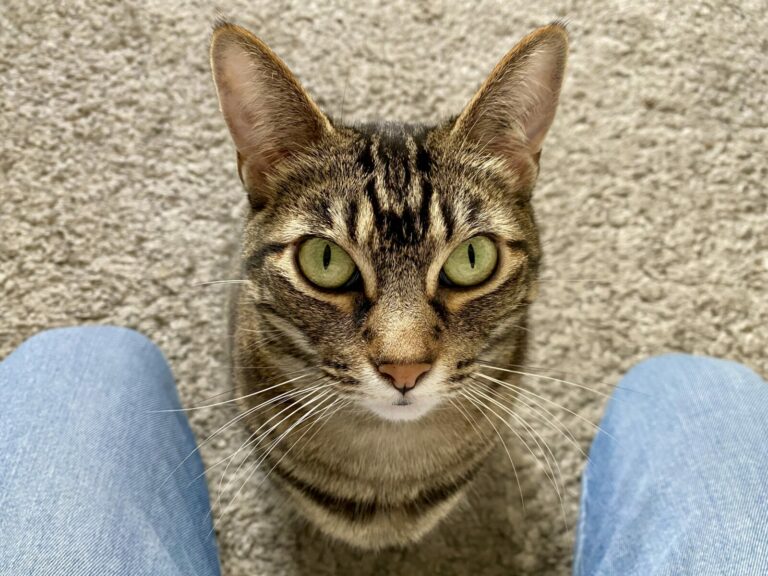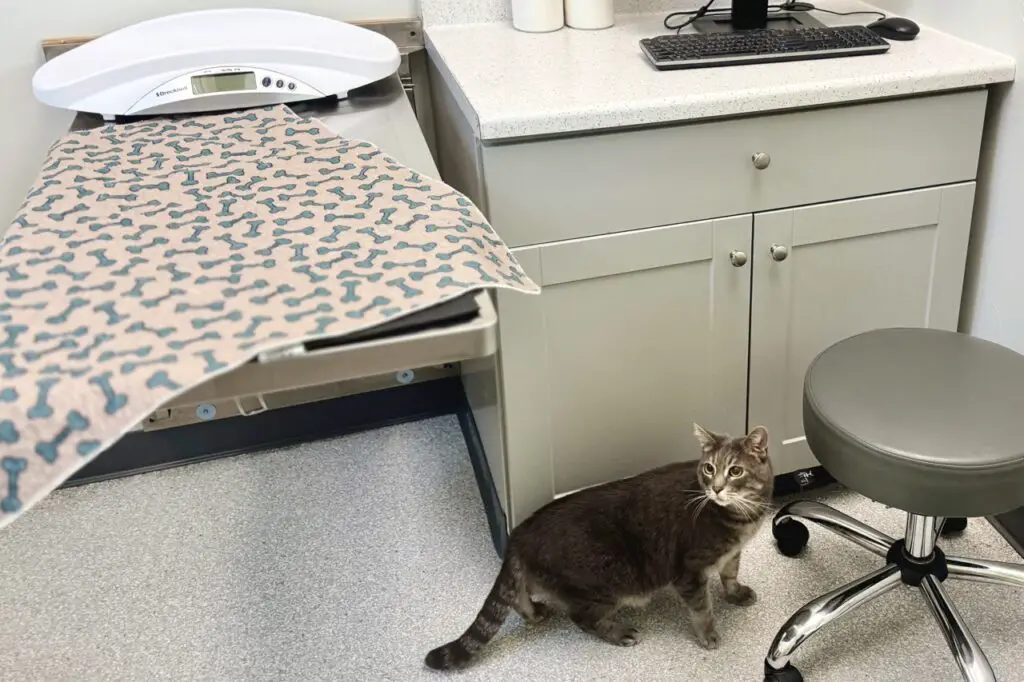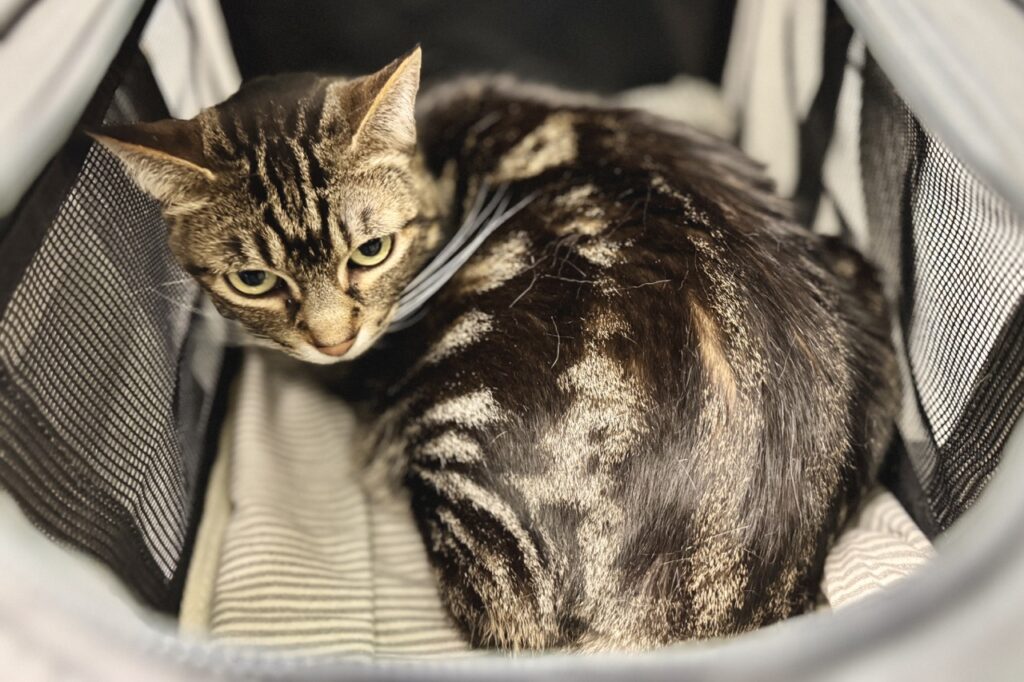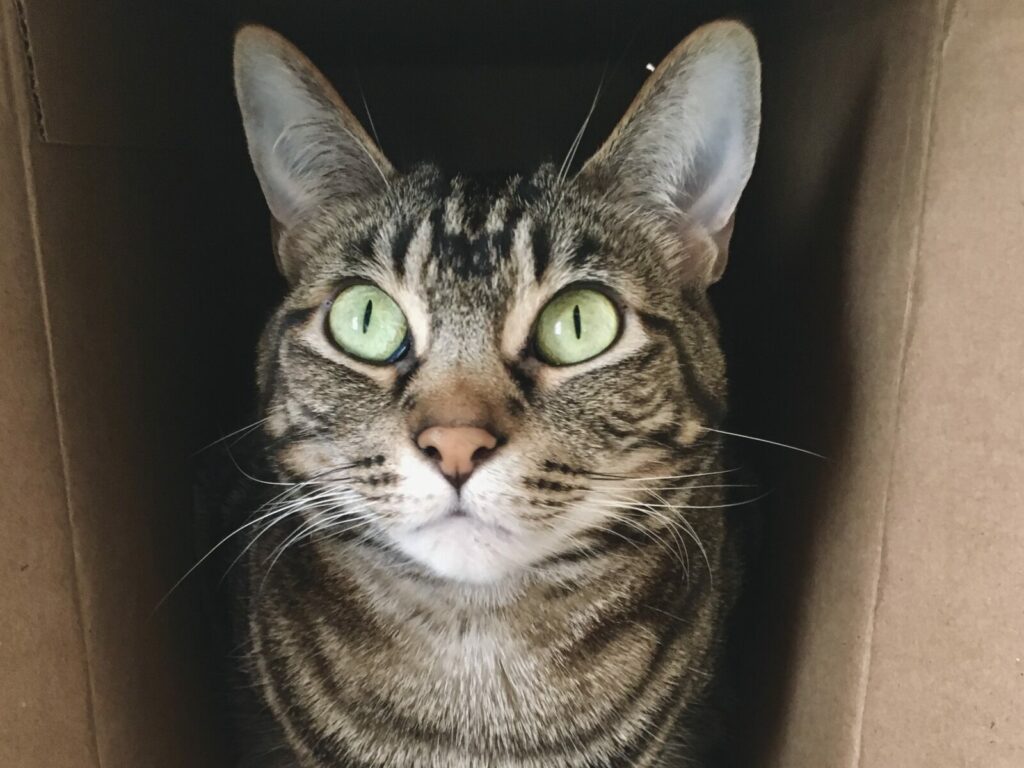How to Tell if Your New Cat is Adjusting (or Stressing)
In this article, we’ll go over all the signs to look for that your new kitten or cat is adjusting well to your home. We’ll also talk about what to expect at first, what’s normal, and when to be concerned.
The first days with a new cat (or kitten) can be both exciting and nerve wracking. You want to help your cat settle in and feel comfortable quickly, and it may be worrisome to see them so stressed out or withdrawn.
But adjustment will happen, especially if you’ve taken steps to set up the right environment for a smooth start with your new cat, along with the essential items for getting started. Be patient, and let the cat get settled at their own pace, on their own terms.
Don’t force anything. And don’t rush the process of letting them explore beyond the safe room. In the meantime, you’ll be watching for signals that your cat is starting to feel more comfortable, and less stressed.

Table of Contents
The first days and weeks with your new cat are important for beginning to build a bond and foundation of trust.
Before we get into the 11 signs of adjustment, let’s talk about why cats need an adjustment period, what stress looks like in cats, and how long the adjustment period typically lasts.
Change is Stressful for Cats – What to Expect at First
Your cat is likely to be quite stressed in the beginning. Being placed in a crate, followed by a car ride, and then taken into an unfamiliar place (your home) will be super stressful and overwhelming.
It is very normal for your cat to be withdrawn and anxious at first. Don’t worry if they don’t do the things you expect a cat to do.
What does a stressed cat look like?
A stressed cat will walk with their body pressed low to the ground and ears pinned back. They may prefer to hide in a dark and cozy nook, or wedge themself into a small space. They may growl or hiss if approached, and they may yowl or groan in distress.
It’s normal for a stressed cat to be uninterested in food, play, touch, or affection, or in exploring the room. It’s also normal for your cat to not be using the litter box or scratching posts at first.
What a Stressed Cat Looks Like
A couple examples of my cats in a state of stress during a visit to the vet’s office in February, 2024. This is how it usually goes. Gandalf is only a bit stressed, while Phoebe is so stressed she is trying to make herself invisible! Poor thing.

Gandalf at the vet’s office: Here’s a cat that is moderately stressed, but comfortable enough to explore. His eyes are big and his rear end is pressed low to the ground.
Phoebe at the vets office: Here’s a very stressed cat. She was unwilling to venture out despite the carrier door being opened wide. Her eyes are big, her ears are pinned back slightly, and she is huddled on all fours into one end of the carrier. She’s also trembling slightly and outwardly indifferent about being touched.

The Importance of a Safe Room and Early Monitoring
The best way to help a cat or kitten settle into a new home is by setting up one room as a safe space ahead of time.
The space should be contained (has a door that can be shut tight), and set up with basic necessities, comforts, and safe/cozy hiding spots. It should also be equipped with a comfy spot for you to hang out in.
You’ll want to make sure you have extra time to devote to your new cat in the very beginning. This will ensure that you’re able to spend time getting to know each other, and monitor the cat’s levels of comfort or distress.
At first, it may be enough for you to just be in the room with your cat, quietly at a distance. Your calm presence will allow them to get used to your scent, and see that you are trustworthy and safe to be around.
How Long Does it Take for a Cat to Adjust to a New Home?
The time it takes to fully adjust to a new home can vary quite a bit depending on the cat’s personality, background, and age, as well as the home environment you are introducing them to.
Affiliate Disclosure: VerveCat is supported by readers. As a member of Amazon Associates and other affiliate programs, we may earn a commission at no added cost to you when you follow a product link and make a purchase.
You should allow at least 2-3 weeks for your cat to adapt and start to feel settled. However, it’s not uncommon for a cat’s transition period to last 2-3 months as they get fully comfortable.
Many people, including my own vet, swear by pheromone diffusers to help reduce stress in cats during times of change or disruption. They are safe to use and are formulated to mimic the natural pheromones, or scents, that cats themselves use to communicate calm vibes to each other.
What is the 3-3-3 Rule for Cats?
The 3-3-3 rule is a general guideline for what to expect in the first 3 days, 3 weeks, and 3 months of a cat’s adjustment to a new home. (Remember, it can vary a lot by individual cat)
- The First 3 Days: It’s typical for a cat to need about 3 days for to decompress or “detox” from the stress of the change. Your cat may be stressed out and withdrawn or shut down for much of this time.
- The Next 3 Weeks: After those first 3 days, expect the next 3 weeks or so to be a gradual shift of your cat feeling less stressed and more at ease. This will be the time for gradual introductions to additional parts of your home, as well as to other people and pets.
- After 3 Months: Finally, by about the 3 month mark, most cats are fully settled in and feeling confident and relaxed in their new home.
11 Signs a Cat is Adjusting
1. Eats and Drinks
What to expect at first
At first, your cat might not show any interest in food or water. This is normal. Just like humans, highly stressed cats don’t have much of an appetite.
Signs your cat is adjusting
Within a day or two, your cat should begin to show an appetite, and drink some water.
Once your cat is eating, this opens up the strategy of using treats to do some comforting as well as initial positive reinforcement training for things like using the litter box and scratching posts.
When to be concerned
If your newly adopted cat is not eating or drinking at all after the first two days, you need to adjust what you’re doing (e.g., try a different food, remove/minimize any sources of stress you can control), and be prepared to consult with your veterinarian.
2. Explores the Surroundings
What to expect at first
At first, your cat may show little or no interest in exploring. Hopefully, you have set up a sanctuary room (safe and calm space) within your home that is enclosed.
A small, quiet room with a closed door is ideal. This will allow your cat to adjust in small, manageable steps. Starting in a large space or in a space that is not contained is likely to be overwhelming and only add stress, while making the adjustment process slower.
Signs your cat is adjusting
It’s a good sign when your cat emerges from hiding and begins to explore the room or show interest in looking out the window. This may happen slowly at first and it’s important to let it be at the cat’s own pace.
Don’t try to “show” them things by picking them up and placing them there. This will likely add to their stress and may cause them to develop a negative association with being picked up.
Eventually, they will get familiar with pretty much every surface, nook, and cranny of the room that they can reach, including high places.
If your cat does explore the safe room right away, you should still keep things contained to that room for at least the first few days. This will allow time for reliable litter box use to develop. It will also help you establish routines with your cat and begin to form a strong and trusting bond.
3. Accepts Touch and Affection
What to expect at first
Don’t be surprised if your cat shrinks away from your touch in the beginning. Stressed cats are often not interested in, or stressed by, interaction.
Don’t force interaction if they seem uncomfortable with it.
If you think your cat is ready for it, try giving a pet or two and take your hand away. Then see if the cat seeks more affection from you. This works best when the cat is up and free to walk around (rather than inside a pet carrier or hiding spot where they might feel trapped).
Signs your cat is adjusting
- Leans forward to sniff your hand
- Allows pets and cheek/head rubs
- Leans into your hand when you give pets or rubs
- Starts purring upon interaction
- Initiates affectionate contact
- Voluntarily reengages in contact after receiving a rub
4. Comes to Greet You When You Enter the Room
What to expect at first
At first, your cat probably won’t come running to say hello when you enter the room. That’s to be expected for a stressed cat who needs some time to take in the smells, sights, and sounds of a new place.
Signs your cat is adjusting
If your cat comes over to say hi when you walk in, this is definitely a sign of feeling comfortable in the space and with you.
5. Uses the Litter Box
What to expect at first
Due to the stress and lack of familiarity with the new surroundings, your cat may not show interest in using the litter box at first. Your cat may not go to the litter box on their own at first. There may also be a few accidents in the beginning.
Proper litter box training is a critical thing to understand and have set up from the very beginning. This will fast track the process and reduce the chances of your cat going to the bathroom elsewhere.
Signs your cat is adjusting
A good sign of adjustment is when your cat begins using the litter box. At first, they may require some coaxing from you. Once they’ve started, they should begin using it voluntarily pretty quickly after that.
When to call the vet
If you have been following the litter box training [vervecat.com/getting-started/acclimate/how-to-train-cat-to-use-litter-box/] guidelines and your cat is still avoiding the litter box after the first several days, you should consult with your veterinarian. This behavior can mean there is a medical issue that needs to be addressed.
6. Shows Interest in Play
What to expect at first
A stressed cat needing time to adjust will not be interested in play. You can try enticing your cat with a toy, but again, don’t force anything.
It will be obvious when your cat is ready for play by the way they respond to your invitation. If they ignore the toy, they’re probably still too stressed for play.
Wand toys can be good for this because it allows you to engage from a distance. Don’t bop the cat with the toy to get it to play – this will not be seen as inviting if your cat isn’t ready to play yet.
Signs your cat is adjusting
- expresses curiosity about toys
- Chases or bats at toys
- Plays with toys on their own
- Shows “hunting” behaviors (e.g., sneaking up on a toy, batting at a moth or fly)
7. Resumes Typical Self-Grooming Behaviors
What to expect at first
A stressed cat doesn’t show much in the way of grooming (cleaning by licking their fur). Excessive licking can be a sign of anxiety or skin irritation. But for a cat being introduced to a new brand new space, it is normal for grooming behaviors to be absent at first.
Signs your cat is adjusting
It’s a good sign when your cat begins to groom. Cats typically spend a lot of time cleaning themselves.
8. Uses Positive Vocalizations
What to expect at first
A stressed cat may meow or yowl in distress, which sounds much different than the meows that come in the form of pleasant greetings or requests for food. If your cat feels very fearful or threatened, they may even growl or hiss.
Signs your cat is adjusting
As your cat begins to settle in, they may meow in anticipation of being fed, or as a request for more affectionate rubs. They may purr in response to a cheek rub.
Keep in mind that some cats are very vocal while others rarely meow. If your cat isn’t vocalizing, but is showing some of the other signs of adjustment, this is good!
9. Seeks Affection, Contact, or Closeness
What to expect at first
Stressed cats typically don’t seek affection or contact, so don’t take it personally if your cat isn’t cuddly or affectionate in the beginning.
Signs your cat is adjusting
If your cat seeks affection or contact with you, this is a good sign. It doesn’t necessarily mean curling up on your lap (an obvious good sign). It could just be a brief headbutt to your hand or pant leg.
Or if the cat has been hiding, simply emerging from the hiding spot to explore or hang out closer to you is a good sign.
10. Uses Scratching Posts
What to expect at first
Stressed and withdrawn cats typically don’t show scratching behaviors. But you should have at least one or two scratching posts strategically placed as part of the sanctuary room you have set up for acclimation.
Signs your cat is adjusting
If your cat begins using a scratching post, this is also a sign that they are beginning to feel comfortable.
Actually, if they begin scratching anything, it’s a sign they’re feeling comfortable. Hopefully it’s a scratching post.
But if it’s your furniture, then you have a golden opportunity to practice your positive reinforcement cat training skills (don’t punish or yell, redirect unwanted behavior, immediately reward wanted behavior).
You want them to develop the habit of using scratching posts as early on as possible. Have treats at the ready so you can reward the behavior when it happens.
11. Has a Relaxed or Confident Posture
What to expect at first
A stressed cat will often flatten their ears and walk very low to the ground with a drooping tail. If they are hiding, it will often be in a huddled position, rather than sprawled out or curled up on their side.
Signs your cat is adjusting
If your cat is walking with a more relaxed and upright posture, it’s a sign they’re feeling more comfortable and confident. Stretching out or rolling onto their back when lying down is also a sign of feeling at ease.
Last Meows
The first days and weeks can be frustrating because you may really be looking forward to cuddles and lap time with your new fur pal.
But it’s important to be patient as you start out with your new cat, remembering that change is extremely stressful for most cats. If you’re unsure whether you should be concerned or not, reach out to your vet’s office and run things past them.
Keep in mind the 3-3-3 rule as a general guide. Set up a safe room ahead of time, don’t force anything, and take things slowly at your cat’s own pace. Adjustment takes time and often happens very gradually.


